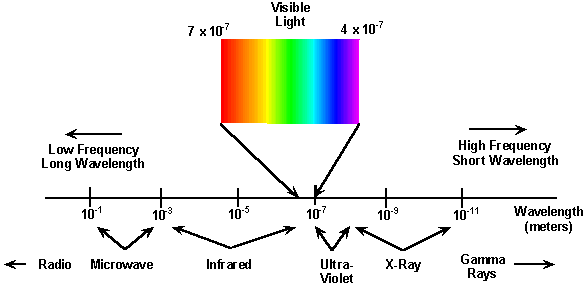Electromagnetic Spectrum
Copyright © 2005 Dave Whitmore

Wavelength and frequency have an inverse relationship to each other. In other words, as the wavelength gets longer the frequency gets lower. There's a fairly simple relationship between frequency and wavelength:
λ = c/f
where λ is the wavelength, c is the velocity of light (3 x 108 meters/second) and f is the frequency in hertz.
Since we're dealing with very large and very small numbers scientific notation is required to represent the quantities. Here are some shortcuts:
1
nanometer (nm) = 10-9 meters
1 micron = 10-9 meters
1 kilohertz (kHz) = 103 hertz
1 metahertz (MHz) = 106 hertz
1 gigahertz (GHz) = 109 hertz
1 terahertz (THz) = 1012 hertz
Here are some wavelength and frequency data to give a perspective on the relationships.
|
λ
(meters)
|
f (Hertz)
|
|
|
Radio
|
>
10-1
|
<=
3 x 10-9
|
|
Microwave
|
10-3
to 10-1
|
3
x 109 to 3 x 1011
|
|
Infrared
|
7
x 10-7 to 10-3
|
3
x 1011 to 4 x 1014
|
|
Visible
Light
|
4
x 10-7 to 7 x 10-7
|
4
x 1014 to 7.5 x 1014
|
|
Ultraviolet
|
10-8
to 4 x 10-7
|
7.5
x 1014 to 3 x 1016
|
|
X-Ray
|
10-11
to 10-8
|
3
x 1016 to 3 x 1019
|
|
Gamma
Ray
|
<
10-11
|
>3
x 1019
|